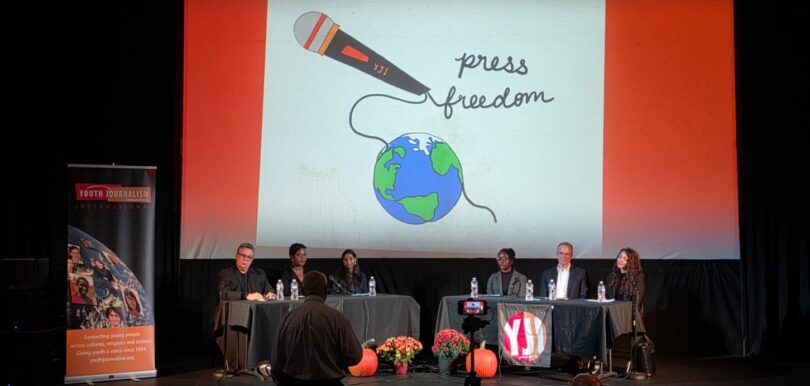Chapel Hill, North Carolina, U.S.A. – Journalism faces serious challenges in a world where social media dominates and the use of artificial intelligence is on the rise, though experts said the profession not only has a future, but is needed.
Listen to the author read this story:
“Journalism is the lifeline of communities,” said television news executive Bervette Carree, “and it’s an honor and a huge responsibility to inform, educate, amplify, elevate every single day.”

Carree, who is vice president of news at ABC11/WTVD, recently joined University of North Carolina Assistant Professor Erin Siegal McIntyre, journalist John Drescher and Duke University Professor Bill Adair on a panel to discuss the future of journalism.
Youth Journalism International sponsored the event, held at the Varsity Theatre in Chapel Hill, N.C. last month. Two YJI student reporters, Sreehitha Gandluri and Dorothy Quanteh, moderated the discussion.
Together, they explored issues like the struggle against political misinformation, the crisis of media trust and the need to prepare for a rapidly shifting news landscape.
From the start, it was clear that technology sits at the heart of the profession’s current turmoil.

Adair – the mind behind the Pulitzer Prize-winning factchecking website PolitiFact – noted how quickly he sensed the shift when generative AI tools entered public use.
“AI could be so easily used by the bad guys,” he said, adding that fact-checking remains “a human enterprise” and that real challenges appear not in detection alone but in persuasion.
“How effective is that fact check for Uncle Bob to convince him that what he just read is wrong?” Adair said. “Uncle Bob is not going to see the fact check.”

Siegal McIntyre, a longtime journalist, pointed to a different concern: accuracy. After testing large language models on basic local-government notes, she found that systems routinely produced fabrications.
“Over 400 words, AI makes up things,” Siegal McIntyre said. “You can use it, but you have to be careful.” Still, she emphasized that literacy around how these tools work – not fear – should guide the next generation.
The conversation soon widened to the pressures shaping journalism far beyond technology.

Drescher, a longtime editor now with the North Carolina-based news site The Assembly, described the dramatic collapse of traditional funding models.
Advertising once covered most newsroom costs, Drescher said. But now, “the revenue problem, not the readership problem,” is what’s hollowing out local reporting, he said.
Nonprofit and subscription-based outlets help fill the gaps, but none offer an easy solution, according to the panelists.
“Startups are struggling with funding,” said Drescher. “There’s no perfect funding model.”
Audience trust – already fragile – adds another layer of difficulty.
Siegal McIntyre described basic media literacy as “the elephant in the room,” arguing that American journalism has not yet figured out how to turn that decline around.
Carree sees the effects daily in broadcast newsrooms. Many viewers, she said, no longer feel connected to the institutions meant to serve them.
“Details matter,” Carree said. “That’s why we are journalists.”
Despite the discouraging trends, moments of optimism threaded through the panel.
Carree expressed certainty that journalism still anchors communities.
“There is a future,” Carree said.
Adair echoed that view. “I think there is a great future for journalists because there is a need for information,” he said, adding that the energy of young reporters gives him hope.
Her students are increasingly drawn to local reporting and public service, Siegal McIntyre said, an encouraging shift at a time when communities across the country are losing their news sources.
“More are succeeding than they are failing,” said Siegal McIntyre.
The panel closed with a frank discussion of ownership, corporate pressure and political hostility, factors that complicate newsroom independence.
Adair said it is terrible what some media owners have done, arguing that some media corporations “caved completely” under political pressure and now place corporate self-interest above democratic values.
Siegal McIntyre urged young journalists to know their rights and build networks of support.
“Never expect your company to be fully behind your back,” Siegal McIntyre said.
Even with those warnings, the overall message remained positive. The profession may be facing a chaotic transition, but the core purpose of journalism remains unchanged.
Accuracy, curiosity, transparency and public service, the panelists agreed, still matter.
Lina Marie Schulenkorf is a Correspondent with Youth Journalism International.



